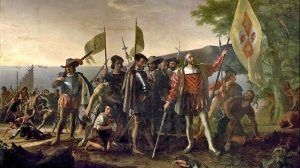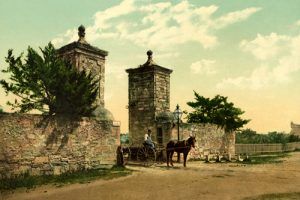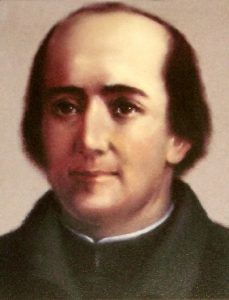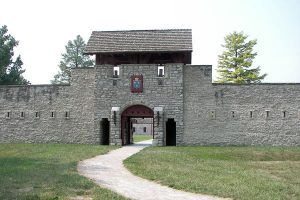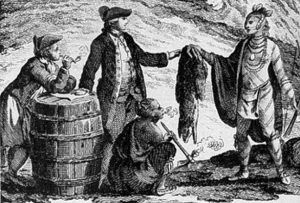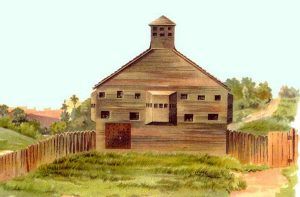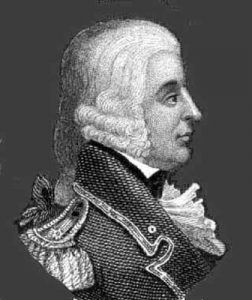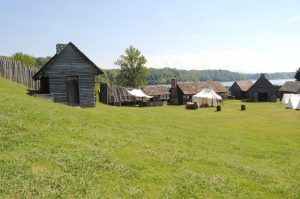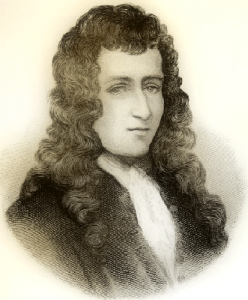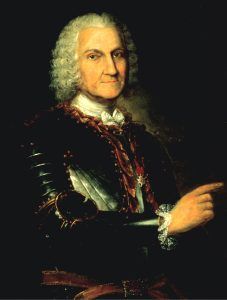By Henry Howe in 1857
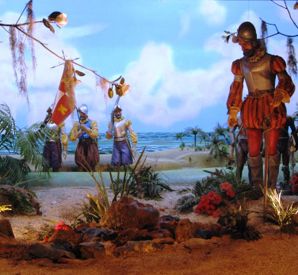
Juan Ponce de Leon
Twenty years after the great event that immortalized the name of Christopher Columbus, Florida was discovered by Juan Ponce de Leon, ex-governor of Puerto Rico. Sailing from that island in March 1513, he discovered an unknown country, which he named Florida, from the abundance of its flowers, the trees being covered with blossoms, and its first being seen on Easter Sunday, a day called by the Spaniards, Pascua Florida. Other explorers soon visited the same coast. In May 1539, Hernando De Soto, the Governor of Cuba, landed at Tampa Bay with 600 followers. He marched into the interior; on May 1, 1541, he discovered the Mississippi River, the first European who had ever beheld that mighty river.
Spain, for many years, claimed the whole of the country — bounded by the Atlantic to the Gulf of the St. Lawrence River on the north, all of which bore the name of Florida. About twenty years after discovering the Mississippi River, some Catholic missionaries attempted to form settlements at St. Augustine and its vicinity. A few years later, a colony of French Calvinists had been established on the St. Marys River near the coast. In 1565, this settlement was annihilated by an expedition from Spain under Pedro Menendez de Aviles; and about 900 French men, women, and children were cruelly massacred. The bodies of many of the slain were hung from trees, with the inscription, “Not as Frenchmen, but as heretics.”
Having accomplished his bloody errand, Menendez founded St. Augustine, Florida, the oldest town by half a century of any now in the Union. Four years after, Dominique de Gourgues, burning to avenge his countrymen, fitted out an expedition at his own expense and surprised the Spanish colonists on the St. MarysRiver; destroying the ports, burning the houses, and ravaging the settlements with fire and sword; finishing the work by also suspending some of the corpses of his enemies from trees, with the inscription “Not as Spaniards, but, as murderers.” Unable to hold possession of the country, De Gourgues retired to his fleet. Florida, excepting for a few years, remained under the Spanish crown, suffering much in its early history from the vicissitudes of war, and piratical incursions, until 1819, when, vastly diminished from its original boundaries, it was ceded to the United States, and in 1845 became a state.
In 1535, James Cartier, a distinguished French mariner, sailed with an exploring expedition up the St. Lawrence River and took possession of the country in the name of his king, called it “New France.” In 1608, the energetic Samuel de Champlain created a nucleus for the settlement of Canada, founding Quebec. This was the same year with the settlement of Jamestown, Virginia, and 12 years previous to that on which the Puritans first stepped upon the rocks of Plymouth, Massachusetts.
Until late in the century, owing to the hostility of the Indians bordering Lakes Ontario and Erie, the adventurous missionaries, on their route west, on pain of death, were compelled to pass far to the north through “a region horrible with forests,” by the Ottawa and French Rivers of Canada.
As yet, no Frenchman had advanced beyond the Fox River of Winnebago Lake in Wisconsin; but, in May 1673, the missionary Jacques Marquette, with a few companions, left Mackinac in canoes; passed up Green Bay, entered the Fox River, crossed the country to the Wisconsin River, and, following its current, passed into and discovered the Mississippi River; down which, they sailed several hundred miles, and returned in the Autumn. The discovery of this great river gave great joy in New France, it being “a pet idea” of that age that some of its western tributaries would afford a direct route to the South Sea and then to China. Monsieur Robert de La Salle, a man of indefatigable enterprise, having been engaged in preparation for several years, in 1682 explored the Mississippi River to the sea and took formal possession of the country in the name of the King of France in honor of whom he called it Louisiana. In 1685, he also took formal possession of Texas and founded a colony on the Colorado River, but La Salle was assassinated, and the colony dispersed.
The descriptions of the beauty and magnificence of the Valley of the Mississippi River, given by these explorers, led many adventurers from the cold climate of Canada to follow the same route and commence settlements. In about 1680, Kaskaskia and Cahokia in Illinois, the oldest towns in the Mississippi Valley, were founded. Kaskaskia became the capital of Illinois country, and in 1721, a Jesuit college and monastery were founded there.
Peace with the Iroquois, Huron, and Ottawa tribes in 1700 allowed the French to settle in the western part of Canada. In June 1701, De la Motte Cadillac, with a Jesuit missionary and a hundred men, laid the foundation of Detroit. All of the vast regions south of the lakes were now claimed by the French under Canada or New France. This excited the jealousy of the English, and the New York legislature passed a law for hanging every Popish priest that should come voluntarily into the province.
The French, chiefly through the mild and conciliating course of their missionaries, had gained so much influence over the western Indians that, when war broke out with England in 1711, the most powerful of the tribes became their allies; and the latter unsuccessfully attempted to restrict their claims to the country south of the lakes. The Fox Nation, allies of the English, in 1713 attacked Detroit; but were defeated by the French and their Indian allies. The Treaty of Utrecht, this year, ended the war.
By 1720, a profitable trade had arisen in furs and agricultural products — between the French of Louisiana and those of Illinois; and settlements had been made on the Mississippi River, below the junction of the Illinois River. To confine the English to the Atlantic coast, the French adopted the plan of forming a line of military posts to extend from the great northern lakes to the Mexican Gulf; and as one of the links of the chain, Fort Chartres was built on the Mississippi River, near Kaskaskia; and in its vicinity soon flourished the villages of Cahokia, and Prairie du Rocher.
At this time, the Ohio River was little known to the French and was a little stream on their early maps. Early in the 1700s, their missionaries had penetrated the sources of the Alleghany River. In 1721, Chabert de Joncaire, a French agent and trader, established himself among the Seneca at Lewistown, and Fort Niagara was erected near the falls five years subsequent. In 1735, according to some authorities, Post St. Vincent was erected on the Wabash River. Almost coeval with this was the military post of Presque Isle, on the site of Erie, Pennsylvania; from there, a cordon of posts extended on the Alleghany River to Pittsburgh; and, from there, down the Ohio River to the Wabash River.
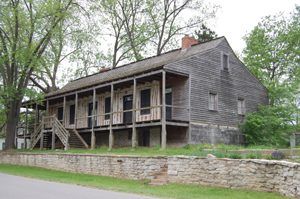
The Janis-Ziegler House, or Green Tree Tavern, in Ste. Genevieve, Missouri, was probably built in the 1790s. The house combines French and American architectural styles. By Kathy Alexander.
In 1749, the French regularly explored the Ohio River and formed alliances with the Indians in western New York, Pennsylvania, and Virginia. The English, who claimed the whole west to the Pacific but whose settlements were confined to the comparatively narrow strip east of the mountains, were jealous of the rapidly increasing power of the French in the west. Not content with exciting the Indians to hostilities against them, they stimulated private enterprise by granting 600,000 acres of choice land on the Ohio River to the “Ohio Company.”
By 1751, there were in the Illinois country the settlements of Cahokia, five miles from St. Louis; St. Philip’s, 45 miles farther down the river; Ste. Genevieve, a little lower still and on the east side of the Mississippi River, Fort Chartres, Kaskaskia, and Prairie du Rocher. The largest of these was Kaskaskia, which contained nearly 3,000 souls at one time.
To strengthen the French dominion’s establishment, Samuel de Champlain’s genius saw that it was essential to establish missions among the Indians. Up to this period, “the far west” had been untrod by the foot of the white man. In 1616, a French Franciscan named Joseph Le Caron passed through the Iroquois and Wyandot nations — to streams running into Lake Huron; and in 1634, two Jesuits founded the first mission in that region. But, just a century had elapsed from the discovery of the Mississippi River, where the first Canadian envoys met the Indian nations, of the northwest, at the falls of St. Mary’s, below the outlet of Lake Superior.
It was not until 1659 that any adventurous fur traders wintered on the shores of this vast lake, nor until 1660 that Rene Mesnard founded the first missionary station upon its rocky and inhospitable coast. Perishing soon after in the forest, it was left to Father Claude Allouez, five years subsequent, to build the first permanent habitation of white men among the northwestern Indians. In 1668, the mission was founded at the falls of St. Marys River by Claude Dablon and Jacques Marquette; in 1670, Nicholas Perrot, agent for the intendant of Canada, explored Lake Michigan to near its southern termination. The French took formal possession of the northwest in 1671, and Marquette established a missionary station at Point St. Ignace, on the mainland north of Mackinac, the first settlement in Michigan.
In 1748, the Ohio Company, composed mainly of wealthy Virginians, dispatched Christopher Gist to explore the country, gain the goodwill of the Indians, and ascertain the plans of the French. Crossing overland to the Ohio River, he proceeded down it to the Great Miami River, up which he passed to the towns of the Miami tribes, about 50 miles north of the site of Dayton, Ohio. The next year the company established a trading post in that vicinity, on Loraroies Creek, the first point of English settlement in the western country. It was soon after broken up by the French.
In 1753, Robert Dinwiddie, governor of Virginia, sent George Washington, then 21 years of age, as commissioner to remonstrate with the French commandant at Fort le Boeuf, near the site of Erie, Pennsylvania, against encroachments of the French. The English claimed the country by her first royal charters, and the French by the stronger title of discovery and possession. The result of the mission proving unsatisfactory, the English, although it was a time of peace, raised a force to expel the invaders from the Ohio River and its tributaries. A detachment under Lieutenant Ward erected a fort on the site of Pittsburgh, Pennsylvania. However, it was surrendered shortly after, in April 1754, to a superior force of French and Indians under Claude-Pierre Pecaudy de Contrecœur. Its garrison was peaceably permitted to retire to the frontier post of Cumberland. Contrecoeur then erected a strong fortification at “the fork” under the name of Fort Duquesne.
Both nations now took measures for the struggle that was to ensue. On May 28, 1755, a strong detachment of Virginia troops under George Washington surprised a small body of French from Fort Duquesne, killed its commander Joseph Coulon de Villiers de Jumonville and ten men, and took nearly all the rest prisoners. He then fell back and erected Fort Necessity near the site of Uniontown, Pennsylvania.
In July, he was attacked by a large body of French and Indians, commanded by Louis Coulon de Villiers, and after a gallant resistance, compelled to capitulate, with permission to retire unmolested; and under the express stipulation that farther settlements or forts, should not be founded by the English, west of the mountains, for one year.
On July 9, 1755, General Edward Braddock was defeated within ten miles of Fort Duquesne. His army, composed mainly of veteran English troops, passed into an ambuscade formed by a far inferior body of French and Indians, who, lying concealed in two deep ravines, each side of his line of march, poured in upon the compact body of their enemy, volleys of musketry, with almost perfect safety to themselves. The Virginia provincials, under George Washington, by their knowledge of border warfare, and remarkable bravery, alone saved the army from complete ruin. General Braddock was mortally wounded by a provincial named Fausett. A brother of the latter had disobeyed the silly orders of the General that the troops should not take positions behind the trees when Braddock rode up and struck him down. Fausett, who saw the whole transaction, immediately drew up his rifle and shot him through the lungs, partly from revenge and partly as a measure of salvation to the army, which was sacrificed to his headstrong stubbornness and inexperience. This battle gave the French and Indians a complete ascendancy on the Ohio River and put a check on the operations of the English west of the mountains for two or three years. In July 1758, General John Forbes, with 7,000 men, left Carlisle, Pennsylvania, for the west. A corps in advance, principally of Highland Scotch, under Major James Grant, was on September 13 defeated in the vicinity of Fort Duquesne on the site of Pittsburgh. A short time after, the French and Indians made an unsuccessful attack upon the advanced guard under Colonel Henry Boquet.
In November, the commandant of Fort Duquesne, unable to cope with the superior force approaching under General John Forbes, abandoned the fortress and descended to New Orleans. On his route, he erected Fort Massac in honor of Marquis de Massiac, who superintended its construction. It was upon the Ohio River, within 40 miles of its mouth — and within the limits of Illinois. Forbes repaired Fort Duquesne and changed its name to Fort Pitt in honor of the English Prime Minister.
The English were now, for the first time, in possession of the upper Ohio River. In the spring, they established several posts in that region, prominent among which was Fort Burd, or Redstone Old Fort, on the site of Brownsville.
Owing to the treachery of South Carolina Governor Lyttleton in 1760, by which 22 Cherokee chiefs on an embassy of peace were made prisoners at Fort George on the Savannah River, that nation flew to arms and for a while desolated the frontiers of Virginia and the Carolinas. Fort Loudoun, in East Tennessee, having been besieged by the Indians, the garrison capitulated on August 7, and the day afterward, while on the route to Fort George, was attacked, and the greater part massacred. In the summer of 1761, Colonel James Grant invaded their country and compelled them to sue for peace. On the north, the most brilliant success had attended the British arms. Ticonderoga, Crown Point, Fort Niagara, and Quebec were taken in 1759, and the next year, Montreal fell, and with it, all of Canada.
By the Treaty of Paris in 1763, France gave up her claim to New France and Canada, embracing all the country east of the Mississippi River, from its source to the Bayou Iberville. The remainder of her Mississippi possessions, embracing Louisiana west of the Mississippi River and the Island of Orleans, she secretly ceded to Spain, which terminated the dominion of France on this continent and her vast plans for empire.
At this period, Lower Louisiana had become of considerable importance. The explorations of Robert de La Salle in the Lower Mississippi country were renewed in 1697 by Lemoine D’ Iberville, a brave French naval officer. Sailing with two vessels, he entered the Mississippi River in March 1698 by the Bayou Iberville. He built forts on the Bay of Biloxi, Mississippi, and at Mobile, Alabama, both of which were deserted for the Island of Dauphine, which was the colony’s headquarters for years. He also erected Fort Balise at the mouth of the river and fixed it on the site of Fort Rosalie, which later became the scene of a bloody Indian war.
After he died in 1706, Louisiana was little more than a wilderness, and a vain search for gold and trading in furs, rather than the substantial pursuits of agriculture, allured the colonists. Much time was lost in discovery journeys and collecting furs among distant tribes. Of the occupied lands, Biloxi was barren land, and the soil of the Isle of Dauiihine was poor. Jean-Baptiste Le Moyne de Bienville, the brother and successor of D’ Iberville was at the fort on the Delta of the Mississippi River, where he and his soldiers were liable to inundations and held joint possession with mosquitoes, frogs, snakes, and alligators.
In 1712, Antoine de Crozat, an East India merchant of vast wealth, purchased a grant of the entire country with the exclusive right of commerce for 16 years. But, in 1717, the speculation having resulted in his ruin, all to the injury of the colonists, he surrendered his privileges. Soon after, several other adventurers, under the name of the Mississippi Company, obtained from the French government a charter, which gave them all the rights of sovereignty, except the bare title, including a monopoly of the trade and the mines. Their expectations were chiefly from the mines; and on the strength of a former traveler, Nicolas Perrot, having discovered a copper mine in the valley of St. Peters, the directors of the company assigned to the soil of Louisiana, silver, and gold, and the mud of the Mississippi River, diamonds and pearls. The notorious Law, who then resided in Paris, was the secret agent of the company. To form its capital, its shares were sold at five hundred lives each, and such was the speculating mania of the times that, in a short time, more than a hundred million was realized. Although this proved ruinous to individuals, the colony greatly benefited from the consequent emigration, and agriculture and commerce flourished.
In 1719, Renault, an agent of the Mississippi Company, left France with about 200 miners and emigrants to carry out the mining schemes of the company. He bought 500 slaves at St. Domingo to work the mines, which he conveyed to Illinois in 1720. He established himself a few miles above Kaskaskia, Illinois, and founded the village of St. Philips. Extravagant expectations existed in France of his probable success in obtaining gold and silver. He sent out exploring parties in various sections of Illinois and Missouri. His explorations extended to the banks of the Ohio and Kentucky Rivers and even to the Cumberland Valley in Tennessee, where at “French Lick,” the French established a trading post on the site of Nashville. Although Renault was woefully disappointed in not discovering extensive mines of gold or silver, he made various discoveries of lead, the mines north of Potosi, and those on the St. Francis River. He eventually turned his attention to the smelting of lead, which he made considerable quantities, and shipped to France. He remained in the country until 1744. Nothing of consequence was again done in mining until after the American Revolution.
In 1718, Jean-Baptiste Le Moyne de Bienville laid out the town of New Orleans on the plan of Rochefort, France. Some four years after, the bankruptcy of Law threw the colony into the most significant confusion and occasioned widespread ruin in France, where speculation had been carried to an extreme unknown before.
The expenditures for Louisiana were consequently stopped, but the colony had now gained the strength to struggle for herself. Louisiana was divided into nine cantons, of which Arkansas and Illinois each formed one.
At about this time, the colony had considerable difficulty with the Indian tribes and was involved in wars with the Chickasaw and the Natchez. This latter-named tribe was finally wholly conquered. Their remnant dispersed among other Indians so that once powerful people, as a distinct race, were entirely lost. Their name alone survives as that of a flourishing city. Tradition-related singular stories of the Natchez. It was believed that they emigrated from Mexico and were kindred to the Incas of Peru. The Natchez alone, of all the Indian tribes, had a consecrated temple where appointed guardians maintained a perpetual fire. Near the temple, on an artificial mound, stood the dwelling of their chief — called the Great Sun; who was supposed to be descended from that luminary, and all abound were grouped the dwellings of the tribe. His power was absolute; the dignity was hereditary and transmitted exclusively through the female line, and the race of nobles was so distinct that usage had molded language into the forms of reverence.
In 1732, the Mississippi Company relinquished its charter to the king after holding possession for 14 years. At this period, Louisiana had about 5,000 whites and 2,500 blacks. Agriculture was improving in all the nine cantons, particularly in Illinois, which was considered the granary of the colony. Louisiana continued to advance until the war broke out with England in 1755, which resulted in the overthrow of French dominion.
Immediately after the peace of 1763, all the old French forts in the west, as far as Green Bay, were repaired and garrisoned with British troops. Agents and surveyors, too, were examining the finest lands east and northeast of the Ohio River. Judging from the past, the Indians were satisfied that the British intended to possess the whole country. That year, the celebrated Ottawa chief, Pontiac, burning with hatred against the English, formed a general league with the western tribes. By the middle of May, all the western posts had fallen — or were closely besieged by the Indians, and the whole frontier, for almost a thousand miles, suffered from the relentless fury of savage warfare. Treaties of peace were made with the different tribes of Indians in the year following, at Niagara, by Sir William Johnson; at Detroit and vicinity by General John Bradstreet, and, in what is now Coshocton County, Ohio, by Colonel Henry Boquet; at the German Flats, on the Mohawk, with the Six Nations and their confederates. By these treaties, extensive tracts were ceded by the Indians in New York and Pennsylvania and south of Lake Erie.
Peace having been concluded, the excitable frontier population began to cross the mountains. Small settlements were formed on the main routes, extending north toward Fort Pitt and south to the headwaters of the Holston and Clinch Rivers in the vicinity of southwestern Virginia. In 1766, a town was laid out near Fort Pitt. Military land warrants had been issued in great numbers, and a perfect mania for western land had taken possession of the people of the middle colonies. The treaty made by Sir William Johnson, at Fort Stanwix, on the site of Utica, New York, in October 1768, with the Six Nations and their confederates, and those of Hard Labor and Lochaber, made with the Cherokee, afforded a pretext under which the settlements were advanced. It was now falsely claimed that the Indian title was extinguished east and south of the Ohio River to an indefinite extent, and the spirit of emigration and speculation in the land significantly increased. Among the land companies formed at this time was the “Mississippi Company,” of which George Washington was an active member.

